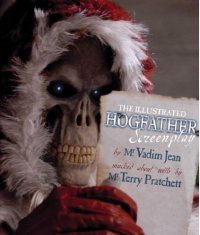
| Terry Pratchett's Hogfather: The Illustrated Screenplay | |||||
| Vadim Jean (& Terry Pratchett) | |||||
| Gollancz, 252 pages | |||||
| A review by Steven H Silver
In addition to Jean's screenplay, the book contains numerous sketches, photos, and production images from the SkyTV production. At
the end of the book is a listing of the cast of the television show. Aside from a pair of forewords by Pratchett and Jean and
an afterword by the show's producers, Rod Brown and Ian Sharples, there is little in the way of extras beyond the scripts. Photos
and sketches are not captioned, relying instead on the reader to use the accompanying script to determine what the pictures
are and who is represented in them.
Of course, Pratchett's plot remains intact, as do his characters (well, when they aren't being killed). The
guild of Assassins has accepted a job to kill the Hogfather and sends Mr. Teatime, who spends his spare time plotting the murders
of mythical figures, off to do the job. Death devotes his time to filling into for the missing Hogfather while his
granddaughter, Susan takes time off from her duties as a nanny to find the missing Hogfather, the Disc's version of Santa Claus.
One difficulty in reading a script is that, even with the lengthy stage directions provided by Jean, the pacing of the story
doesn't quite fit. In his original novel (Hogfather, 1996), Pratchett could pace the events between lines of
dialogue with his expository passages, and in the television show, the director and editor can set the pacing using camera shots
and music. In the screenplay, however, the periods between dialogue don't come across well, no matter how much stage direction
is given, as in, for example, Jean's direction for Susan to look at Twyla's picture on page 48 of the script. Without the
film's timing, it seems more an intrusion than anything else.
Being a textual representation of the advance of Discworld into a new media, Jean must reintroduce concepts which are generally
familiar to Discworld readers for a potential new audience, whether it is the introduction of the world itself or the recurring
characters. Jean does this quite well in the script and it can be assumed that the cinematic representation would build upon
the groundwork that Jean laid.
The book is printed on a nice, thick, high gloss paper, which reproduces the photographic images quite well, giving the book a
lush look and feel to it. The black text stands out quite well, whether it is the script or some of the sketches, such as
the line drawing of the tooth fairy's entrance hall on page 84 (and the photographic comparison on the opposite page).
While a beautiful book in its own right, Terry Pratchett's Hogfather: The Illustrated Screenplay takes a backseat
to the SkyTV production it chronicles and to Pratchett's own novel, both of which should be enjoyed prior to reading
this book. However, the illustrations and sketches included in the book do make a nice addition to any Discworld library.
Steven H Silver is a five-time Hugo Nominee for Best Fan Writer and the editor of the anthologies Wondrous Beginnings, Magical Beginnings, and Horrible Beginnings. He is the publisher of ISFiC Press. In addition to maintaining several bibliographies and the Harry Turtledove website, Steven is heavily involved in convention running and publishes the fanzine Argentus. | |||||
|
|
If you find any errors, typos or other stuff worth mentioning,
please send it to editor@sfsite.com.
Copyright © 1996-2014 SF Site All Rights Reserved Worldwide
